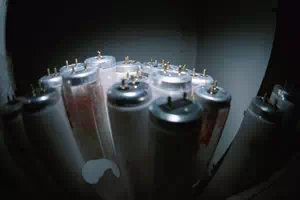 Waste Reduction—Fluorescent Lamps
Waste Reduction—Fluorescent Lamps
Fluorescent lamps use one quarter the energy of incandescent lamps and last as much as ten times longer. The use of fluorescent lighting in healthcare facilities can significantly reduce energy consumption
However, fluorescent lamps contain small amounts of mercury. The release of mercury into the environment creates serious problems.
To reap the benefits greater efficiency while minimizing the mercury burden on the environment, fluorescent lamps must be disposed of responsibly. Fluorescent lamps are classified as hazardous wastes under federal rules. This means, among other things, that it is illegal to dispose of them in dumpsters as common municipal waste. Note that the same hazardous waste rules apply to other mercury- containing lamps, including:
- high-intensity discharge (HID)
- neon
- mercury vapor
- high pressure sodium
- metal halide
Hazardous waste disposal rules are somewhat burdensome, but for certain common items, including fluorescent lamps, the rules give you a break. Used fluorescent lamps are among a number of hazardous waste products that qualify for special treatment under a classification referred to as universal waste. Other examples of these wastes include batteries, thermostats (such as mercury-containing thermostats), and certain waste pesticides. EPA established the universal waste rule as a way to encourage recycling efforts. Under the universal waste rule, a hazardous waste generator has the option of handling eligible types of waste according to somewhat less stringent regulations. Individual states can modify the federal (EPA) regulations, so the rules that apply to your facility will depend on your location. Some states allow additional wastes, beyond those on the federal list, to qualify as universal wastes. See the Universal Waste State Resources Locator for detailed information on your state.
Not all fluorescent bulbs are created equal. Low-mercury, or "green end cap" lamps contain less mercury than common lamps. Hazardous waste status is determined according to the quantity of toxic material released when the waste matrial is subjected to a mild acid (the so-called toxicity characteristic leaching procedure or TCLP). Some lamps may have a sufficiently small quantity of mercury that they pass the TCLP test, and are therefore not considered hazardous wastes. However, these lamps still contain small quantities of mercury and, whatever their regulatory status, they should be safely handled and disposed of to protect the environment.
Purchasing lamps that are both highly efficient and have low mercury content is beneficial in some unexpected ways. Of course, lamps that require less energy and that do not need to be replaced as frequently can be much less costly over their service life. And their lower mercury content poses less risk of releasing mercury to the environment at end-of-life. But high-efficiency lamps also reduce the environment's mercury burden during their service life. Most of the electrcity used in the U.S. comes from burning coal. Mercury is typically present in coal, and is released when coal is burned -- in fact, power plants are the leading sources of mercury contamination. By reducing the demand for electrcity, the use of fluorescent lamps mitigates that source of mecury emissons as well.
Using efficient fluorescent lamps reduces pollution — and so does recycling them when they are spent. Establishing an effective and sustainable recycling program at your facility basically involves:
- assessing your facility –how many fluorescent lamps do you use?
- choosing a recycler
- storing used lamps in Universal Waste-compliant containers
- properly managing broken lamps
- keeping records
Here are two useful guides to help you establish a recycling program:
- How to Recycle Mercury Lamps in 8 Easy Steps. Sponsored by the Northeast Waste Management Officials’ Association (NEWMOA). This is an EPA-funded project.
- Fluorescent Lamp Recycling -- 10 Steps to Implementing a Fluorescent Lamp Recycling Program. To help you state a fluorescent lamp recycling program, Practice Greenhealth has developed a 10-step process.
Recycling companies can also be an effective resource when establishing your recycling program. There are various sources available for finding a recycling company. Check below under More Resources.
EPA Lamp Recycling Initiative was created promote mercury lamp recycling by commercial and industrial users. The outreach program aims to increase awareness of the proper disposal methods of these lamps in compliance with federal and state universal waste rules. EPA awarded funds in the form of ten cooperative agreements for the development and implementation of a coordinated nationwide mercury-containing lamp recycling outreach program. This program is currently being implemented in two phases. The following recipients of phase one cooperative agreements are developing outreach materials such as fact sheets, recycling database, websites, public service announcements, and educational materials:
- Association of Lighting and Mercury Recyclers (ALMR)(in collaboration with National Electrical Manufacturers Association (NEMA), and Solid Waste Association of North America (SWANA) )
- Northeast Waste Management Officials' Association (NEWMOA)
EPA’s Universal Waste Website provides regulatory and comparative information about universal waste, how universal wastes are regulated in your state, guidance and recycling resources.
Fluorescent Lamp Recycling: 10 Steps to a Successful Program is a fact sheet from the Practice Greenhealth Program. This guide also contains links to other resources for fluorescent lamp recycling.
Mercury in Lamps Fact Sheet, developed by INFORM, Inc., an environmental research organization, includes information on mercury in lamps, recommendations for lamp-purchasing contracts, advice on how to determine if a lamp is low mercury, and other purchasing considerations.



